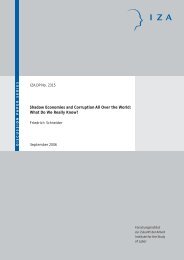Health Outcomes and Socio-Economic Status among ... - Index of - IZA
Health Outcomes and Socio-Economic Status among ... - Index of - IZA
Health Outcomes and Socio-Economic Status among ... - Index of - IZA
You also want an ePaper? Increase the reach of your titles
YUMPU automatically turns print PDFs into web optimized ePapers that Google loves.
that all buildings in the PSU had been properly identified, <strong>and</strong> that dwelling units within multi-<br />
dwelling buildings had been correctly coded before choosing the sample <strong>of</strong> households.<br />
Once the sampling frame for a PSU was completed <strong>and</strong> entered into the lead person’s<br />
computer, a CAPI (computer assisted personal interview) program was used to sample<br />
households <strong>and</strong> to conduct the interviews using laptops. The number <strong>of</strong> households sampled was<br />
greater than the targeted sample size <strong>of</strong> 16 households per PSU in anticipation <strong>of</strong> non-response<br />
<strong>and</strong> sampled households’ not having any members aged 45 or older. The number <strong>of</strong> households<br />
sampled was 36 in urban PSUs <strong>and</strong> 30 in rural PSUs. We interviewed all age-eligible sample<br />
households in each PSU who were willing to participate in the survey, ultimately interviewing<br />
1,570 households containing 2,685 respondents aged 45 <strong>and</strong> over <strong>and</strong> their spouses. 3<br />
In this paper we use data on all respondents 45 year <strong>of</strong> age <strong>and</strong> older, 4 some 2,238<br />
respondents. Tables <strong>and</strong> figures are weighted using individual sample weights. 5 All figures are<br />
nonparametric <strong>and</strong> drawn using LOWESS. Regressions are run unweighted. The sampling<br />
scheme is independent <strong>of</strong> our health variables (depending only on region <strong>and</strong> urban/rural area<br />
within the province) so weights are not needed to correct for any bias from the sampling. Of<br />
course refusals can cause bias. Given that a household participates, virtually all sampled<br />
respondents do as well for the main questionnaire (Zhao et al., 2009). For the biomarkers there<br />
3 The contact <strong>and</strong> interview rate was 86% <strong>of</strong> those households that were chosen to be sampled. This is much better<br />
than HRS-type surveys in the US <strong>and</strong> Europe, which now tend to be in the 60 or even 50 percent range, <strong>and</strong><br />
compares favorably with other surveys done in Asia.<br />
4 Spouses who are under 45 years old are dropped from this analysis.<br />
5 Here we use the sample weights allowing for household non-response using local community dummies to predict<br />
household nonresponse. We do not incorporate non-response for the biomarkers in the weights. The results using<br />
weights that do so using inverse probability weights (IPW) are similar in nature. Incorporating non-response with<br />
IPW requires an assumption <strong>of</strong> selection on observables, which is very strong <strong>and</strong> unlikely to be met. Using more<br />
st<strong>and</strong>ard selection methods is best using exclusion restrictions, which we do not plausibly have.<br />
11
















